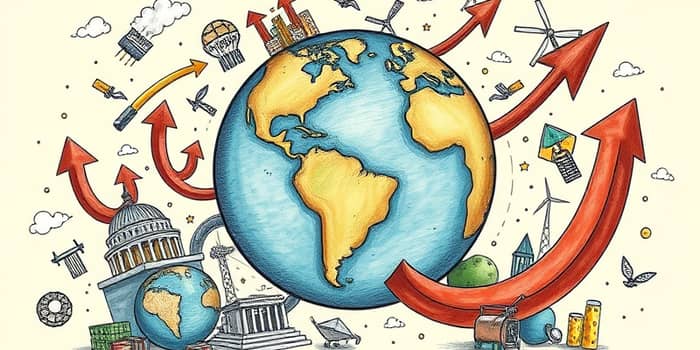
Inflation dynamics are reshaping financial landscapes, influencing everything from consumer prices to corporate strategies. As global rates shift, staying informed and adaptable becomes essential. This analysis delves into recent trends, country comparisons, underlying causes, and practical measures for navigating uncertainty.
The world economy has witnessed notable volatility in recent years. At the forefront is the global average inflation rate for 2025, forecast at 4.0%, a slight uptick from earlier quarters. Long-term projections suggest a gradual easing to 3.9% in 2026 and 3.8% by 2028, but these figures still exceed pre-pandemic norms.
Historical spikes reached nearly 9% in late 2022, driven by pandemic-related bottlenecks, geopolitical conflicts, and surging demand. While prices have moderated since then, the pace of decline has slowed, signaling persistent risks. Factors such as long-term inflation expectations have trended upward underscore the need for vigilance.
Key drivers include:
Energy costs, particularly oil and gas, remain central to forecasts. While coal and uranium prices may ease in 2025, U.S. and European gas markets face upward pressure from increased LNG exports.
Inflation experiences vary widely across economies. In early 2025, Russia led major nations with a 9.9% rate, prompting a steadfast policy rate of 21%. Conversely, China recorded deflationary readings between –0.1% and 0.5%, reflecting weakened demand in key sectors.
Major economies such as the United States, the United Kingdom, and the European Union began cutting rates in mid-2024 as headline inflation eased. Japan maintained a 0.5% policy rate, illustrating divergent policy paths. Such disparities highlight the complex balancing act central banks face between growth and price control.
Notable country data:
Inflation emerges from a blend of supply-side shocks and demand-driven pressures. The pandemic and geopolitical tensions disrupted production and logistics, creating bottlenecks that reverberated through global markets.
On the demand side, consumers unleashed pent-up savings as economies reopened, fueling price surges in sectors like housing and autos. Trade measures also play a role: U.S. tariffs on vehicles and parts, for instance, are estimated to boost PCE prices by 1–1.5%, potentially lifting car costs by over 11% if fully passed through.
Wage accords and fiscal stimulus have further complicated the outlook. robust wage growth and fiscal policy in many regions support household incomes but also add to persistent cost pressures. The interplay of these factors determines whether elevated inflation persists or recedes.
Enterprises and investors are adapting to a landscape marked by uncertainty. Contractual arrangements increasingly reference the Producer Price Index to preserve margins and ensure fairness over extended periods.
The PPI’s broad coverage and objectivity make it a preferred benchmark. By incorporating escalation clauses in contracts to manage price volatility, firms can mitigate risks while securing supply relationships.
Consumers, meanwhile, face higher prices in affected sectors reduce disposable income, forcing reassessments of spending patterns. As central banks signal rate cuts, investors must weigh the prospects of easing borrowing costs against lingering inflationary uncertainty.
In this environment, proactive measures can soften the blow of rising costs and capitalize on emerging opportunities. Businesses should diversify supply chains, lock in long-term agreements, and leverage technology to optimize operations.
Households can protect their purchasing power by adjusting budgets, seeking value in essentials, and exploring high-yield savings options. Financial advisors recommend maintaining a balanced portfolio that includes inflation-protected securities and real assets.
While forecasts point to a gradual decline in headline rates, structural factors may sustain price pressures above historical norms. Trade policies, labor market tightness, and climate-related disruptions all warrant close monitoring.
Successful navigation demands clarity, flexibility, and forward-looking planning. By understanding the forces at play and adopting resilient strategies, stakeholders can not only weather inflationary storms but also thrive in the new economic reality.
References













